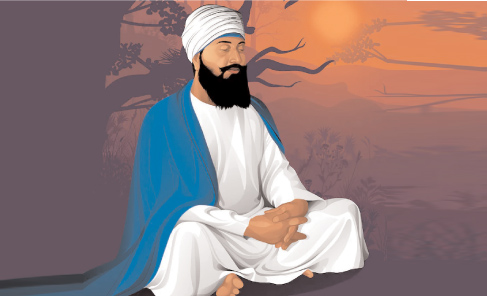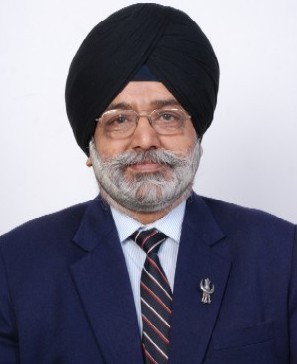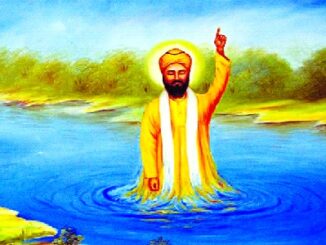
ਨਿਰਭਉ ਨਿਰਵੈਰੁ ਤੋਂ ਭੈ ਕਾਹੂ ਕਉ ਦੇਤ ਨਹਿ ਨਹਿ ਭੈ ਮਾਨਤ ਆਨ।। ਤਕ ਦਾ ਸਫਰ
From being “fearless and without enmity” to “giving fear to none, nor fearing anyone,” such was the journey of Guru Tegh Bahadur Ji.

Panthic poet Teja Singh Sabhar beautifully described a garland of martyrdoms:
ਸੁਰਗਾਂ ਦੇ ਵਿਚ ਬੈਠੀਆਂ ਹੈਸਨ, ਇਕ ਜਗ੍ਹਾ ਸਰਕਾਰਾਂ ਦੋ।
ਵੇਖਣ ਵਾਲੇ ਵੇਖ ਰਹੇ ਨੇ ਬੁਤ ਏ ਇਕ ਨੁਹਾਰਾ ਦੋਂ।
ਗੱਲਾਂ ਵਿਚੋਂ ਗਲ ਇਹ ਨਿਕਲ ਗੱਲ ਏ ਇਕ ਵਿਚਾਰਾਂ ਦੋ।
ਇਕ ਨੇ ਪੰਚਮ ਪਿਤਾ ਪਿਆਰੇ, ਇਕ ਉਹਨਾਂ ਦੇ ਪੋਤੇ ਜੋ।
ਉਸ ਪੋਤੇ ਨੇ ਪੋਤੇ ਲੈ ਲਏ, ਦੋ ਏਧਰ ਤੇ ਏਧਰ ਦੋ।
In the heavens sit two divine emperors,
Beheld by many as two wondrous figures.
From their talks emerged a single thought,
One is the Fifth Guru, the other his grandson Ninth Guru.
The grandson took his grandsons on His laps –two each of both sides.
This chain of martyrdoms began with Guru Arjan Dev Ji’s sacrifice, followed by a series of martyrdoms.
On 24 November 1675, near the Red Fort in Delhi, the Ninth Guru, Sri Guru Tegh Bahadur Ji, was martyred on the orders of Aurangzeb. In human history, this event stands unique from many perspectives, with no parallel example. Guru Gobind Singh Ji, in his autobiography, wrote about this martyrdom:ਤੇਗ ਬਹਾਦੁਰ ਸੀ ਕ੍ਰਿਆ ਕਰੀ ਨ ਕਿਨਹੂੰ ਆਨਿ ॥੧੫॥“Tegh Bahadur performed a deed unmatched by anyone else.”
Throughout world history, countless sacrifices have been cherished in the heart of humanity, impossible to erase. But what was so special about Guru Tegh Bahadur Ji’s martyrdom that led Guru Gobind Singh Ji to declare it the ultimate act, beyond which none could go? Was this martyrdom merely a momentary event, destined to fade with time? If so, it would be an injustice to that great sacrifice. In reality, Guru Tegh Bahadur Ji’s martyrdom has many dimensions and facets. Even after 350 years, the same causes, oppressions, and injustices persist across the globe. Mankind is facing the same issues, only the perpetrators and victims have changed. It seems humanity has neither fully valued nor learnt from this sacrifice. Thus, its significance and relevance remain as strong today as ever. Guru Gobind Singh Ji’s words affirm:“Deities and demons were created.” (Dasam Granth)ਦੇਵ ਦੈਤ ਜਛਨ ਉਪਜਾਯੋ।। (ਦ.ਗ੍ਰ.)
If these two forces continue to coexist in the world, Guru Tegh Bahadur Ji’s martyrdom will forever inspire humanity.
A poet beautifully captured this sacrifice:
ਵਾਰ ਕੇ ਸੀਸ ਜਗਾਇ ਦੀਏ ਸਭ, ਸੋਏ ਪੜੇ ਥੇ ਜੋ ਪਾਇ ਪਸਾਰੇ।
ਕੰਠ ਲਗਾਇ ਅਭੇਦ ਕੀਏ ਜਨ, ਨੀਚ ਅਜਾਤ ਅਛੂਤ ਵਿਚਾਰੇ।
ਚਾਰ ਦਿਸ਼ਾ ਜਿਨ ਕੀ ਕਿਰਪਾ ਹੂੰ ਤੇ, ਬਾਜਤ ਹੈਂ ਅਬ ਸੰਖ ਨਗਾਰੇ।
ਧੰਨ ਗੁਰੂ ਗੁਰ ਤੇਗ਼ ਬਹਾਦੁਰ, ਸੀਸ ਧਰੋਂ ਤਿਨ ਕੇ ਚਰਨਾਰੇ।
He gave his head to awaken those asleep,
Embraced and revealed the plight of the oppressed and outcast.
By his grace, drums and conch shells resound in all four directions.
Blessed Guru Tegh Bahadur, I lay down my head at thy feet.
The foundation of this sacrifice lies in Guru Nanak Dev Ji’s divine proclamation, describing the Creator as Nirbhau (fearless) and Nirvair (without enmity). He firmly stated that without embracing these two divine qualities, one cannot connect with God. Guru Tegh Bahadur Ji embodied this message by living the principle:“Gives fear to none, nor fears anyone.”ਭੈ ਕਾਹੂ ਕਉ ਦੇਤ ਨਹਿ ਨਹਿ ਭੈ ਮਾਨਤ ਆਨ।।The words “fearless and without enmity” sound appealing, but to live them in the face of tyrants like Babur or Aurangzeb requires the courage of a true divine soul.
History bears witness that being both fearless and without enmity at the same time is extremely difficult. Every coward claims to be no enmity, and every tyrant claims to be fearless. But Gurmat demands both qualities simultaneously, and Guru Tegh Bahadur Ji proved this through his actions, showing he would neither instill fear nor accept it.
In world history, there are countless examples of sacrifices for oneself, family, community, or faith. But to give one’s life for another’s religion, for their religious rights, and for freedom of conscience—that’s a lighthouse illuminating Chandni Chowk. This is why Guru Gobind Singh Ji gave the profound principle that, at the level of humanity, there can be no discrimination. His words state:“When the illusion of the heart is removed, what difference remains between Hindu and Turk?”ਜਾਂ ਤੇ ਛੂਟ ਗਯੋ ਭ੍ਰਮ ਉਰ ਕਾ, ਤਿਸ ਆਗੇ ਹਿੰਦੂ ਕਯਾ ਤੁਰਕਾ।This means that for one whose heart is free of duality, the distinction between Hindu and Muslim vanishes.
This sacrifice was for the protection of religious symbols—the tilak and sacred thread—which Guru Nanak Dev Ji had rejected for his own path, declaring that his followers would not be bound by such rituals. Yet, Guru Tegh Bahadur Ji’s sacrifice for those very Hindu symbols stunned the world.
As a poet said:
ਸਿਰ ਰਾਖੇ ਸਿਰ ਜਾਤ ਹੈ, ਸਿਰ ਕਾਟੇ ਸਿਰ ਸੋਹੇ।
ਜੈਸੇ ਬਾਤੀ ਦੀਪ ਕੀ ਕਟੇ ਉਜਿਆਰਾ ਹੋਏ।।
“Head saved, head lost. Head severed, yet it shines.
Like a lamp’s wick cut, but still giving light.”
In 1934, the renowned freedom fighter Bhai Parmanand, upon returning from abroad and visiting Kashmir, wrote in his book Story of My Life (p. 178):“Whenever I see a tilak on the forehead of a Brahmin boy in Kashmir, my head instinctively bows in gratitude to God, reminding me of the great sacrifice of Guru Tegh Bahadur Ji.”
However, a bitter truth remains: in 1675, at the age of 54, Guru Tegh Bahadur Ji gave an unparalleled sacrifice for the Hindu faith. At that time, Guru Gobind Singh Ji was just nine years old. Yet, just 12 years later, Hindu hilly rulers allied with Aurangzeb’s forces to attack Guru Gobind Singh Ji. Such is the paradox of the world.
The place where Guru Ji’s head was severed is called Sis Ganj. His head was cremated at Anandpur Sahib, and his body was cremated at Baba Lakhi Shah Vanjara’s haveli, now Rakab Ganj Sahib in Delhi. Both Chandni Chowk and Anandpur Sahib are known as Sis Ganj Sahib. Where Sikhs offer their heads, those places are called Shaheed Ganj (martyrdom shrines). Sis Ganj is a seed from which countless Shaheed Ganjs have sprouted.A poet wrote:
ਸ਼ਮਾਂ ਭੀ ਕਮ ਨਹੀਂ, ਕੁਛ ਇਸ਼ਕ ਮੇਂ ਪਰਵਾਨੇ ਸੇ।
ਜਾਨ ਦੇਤਾ ਹੈ ਮਗਰ ਵੋ, ਤੇ ਯੇ ਸਰ ਦੇਤੀ ਹੈ।
“The candle is no less than the moth in love.
The moth gives its life, but this one gives its head.”
During Guru Nanak Dev Ji’s time, when Babur invaded India, He stood up for oppressed Hindus and Muslim women alike, crying out:“Muslim women read their scriptures, yet suffer in agony, O Lalo!”(M:1, 723)ਮੁਸਲਮਾਨੀਆ ਪੜਹਿ ਕਤੇਬਾ ਕਸਟ ਮਹਿ ਕਰਹਿ ਖੁਦਾਇ ਵੇ ਲਾਲੋ।। (ਮ:੧ ੭੨੩)।
But during Aurangzeb’s persecution of Hindus, Guru Tegh Bahadur Ji gave his head.
As has been said by Guru Gobind Singh ji:“Be it Babur or Baba, both are in the hands of the Divine.” (Dasam Granth)ਬਾਬੇ ਕੇ ਬਾਬਰ ਕੇ ਦੋਊ।। ਆਪ ਕਰੈ ਪਰਮੇਸਰ ਸੋਊ।।(ਦ.ਗ੍ਰੰ.)
The “Shield of India,” Guru Tegh Bahadur Ji’s martyrdom at the hands of Aurangzeb, was documented by Guru Gobind Singh Ji himself, stating that his father protected the tilak and sacred thread of Hindus. This is profoundly significant. In 1975, during the 300th anniversary of Guru Tegh Bahadur Ji’s martyrdom, a malicious attempt was made to spread the false narrative that his martyrdom was not for religious freedom or the tilak and sacred thread but for disrupting law and order, for which he was punished according to the law.
However, the uproar that followed forced the professor who propagated this to admit that the most reliable testimony is an autobiography, and Guru Gobind Singh Ji’s own writings detailed the truth. This quelled the falsehood.
Thus, Guru Gobind Singh Ji’s words in his Bani are of utmost importance:
ਤਿਲਕਜੰਞੂਰਾਖਾਪ੍ਰਭਤਾਕਾ ॥ਕੀਨੋਬਡੋਕਲੂਮਹਿਸਾਕਾ॥
ਸਾਧਨ ਹੇਤਿ ਇਤੀ ਜਿਨਿ ਕਰੀ ॥ਸੀਸੁ ਦੀਯਾ ਪਰੁ ਸੀ ਨ ਉਚਰੀ ॥੧੩॥
“He protected the tilak and sacred thread, performing a great deed in this dark age.
For the sake of the righteous, he gave his head but did not utter a cry.”
Yet now, attempts are being made again, in hushed tones, to claim that this Bani is not even Guru Gobind Singh Ji’s. This is part of a deeper conspiracy to erase the crucial testimony of Guru Tegh Bahadur Ji’s martyrdom, as if to martyr him again.
Guru Gobind Singh Ji presented another dimension of this martyrdom, stating it was for Dharma, and Guru Ji gave his head but not his resolve:“For the sake of Dharma, he gave his head but did not surrender his principles.”ਧਰਮ ਹੇਤ ਸਾਕਾ ਜਿਨਿ ਕੀਆ ॥ਸੀਸੁ ਦੀਆ ਪਰੁ ਸਿਰਰੁ ਨ ਦੀਆ ॥
However, an equally significant point is Guru Tegh Bahadur Ji’s rejection of performing miracles, which renowned scholar Dr. J.S. Grewal highlights in Guru Tegh Bahadur and Persian Chronicles with multiple references. Historical texts like Khalsanama by Bakht Mal, Tarikh-e-Punjab by Ghulam Muhiyuddin Bute Shah, Risala Dar Ahwal-i-Nanak Shah Darvesh by Budh Singh, Umdat-ut-Tawarikh by Sohan Lal, Tawarikh-e-Sikhan by Khushwaqt Rai, Char Bagh-e-Punjab by Ganesh Das, and Ibratnama by Aliuddin are particularly noteworthy.
In Islamic philosophy, miracles (karamat) are believed to be a power possessed by auliya (those close to Allah). The authorities wanted to confirm that Guru Tegh Bahadur Ji was not an auliya. However, not only did Guru Ji refuse to display miracles, but he also declared:
“Performing theatrical miracles is a futile act. It brings shame to the divine.”
ਧਰਮ ਹੇਤ ਸਾਕਾ ਜਿਨਿ ਕੀਆ ॥ਸੀਸੁ ਦੀਆ ਪਰੁ ਸਿਰਰੁ ਨ ਦੀਆ ॥
ਨਾਟਕ ਚੇਟਕ ਕੀਏ ਕੁਕਾਜਾ ॥ਪ੍ਰਭ ਲੋਗਨ ਕਹ ਆਵਤ ਲਾਜਾ ॥੧੪॥
Thus, Guru Ji dismissed miracles as mere “tricks of jugglers.”
In Islamic tradition, extraordinary and supernatural acts are divided into four categories:
- Mu’jiza: Miracles performed by prophets.
- Karamat: Miracles performed by auliya (saints).
- Ma’unat: Acts performed by mystics or those in a state of divine ecstasy.
- Istidraj: Acts performed by those outside the fold of true faith.
(Source: Punjabi Sufi Sahit Sandarbh Kosh, Gurdev Singh, p. 128)
Despite these categorizations, Guru Tegh Bahadur Ji refused to perform miracles. It is said that he was even asked to publicly declare that he possessed no miraculous powers. However, Guru Ji neither performed miracles nor denied having them.
Guru Ji’s martyrdom followed, which Guru Gobind Singh Ji immortalized in his writings:
ਦੋਹਰਾ ॥ਠੀਕਰ ਫੋਰਿ ਦਿਲੀਸ ਸਿਰਿ ਪ੍ਰਭ ਪੁਰਿ ਕੀਯਾ ਪਯਾਨ ॥
ਤੇਗ ਬਹਾਦੁਰ ਸੀ ਕ੍ਰਿਆ ਕਰੀ ਨ ਕਿਨਹੂੰ ਆਨਿ ॥੧੫॥
ਤੇਗ ਬਹਾਦੁਰ ਕੇ ਚਲਤ ਭਯੋ ਜਗਤ ਕੋ ਸੋਕ ॥
ਹੈ ਹੈ ਹੈ ਸਭ ਜਗ ਭਯੋ ਜੈ ਜੈ ਜੈ ਸੁਰ ਲੋਕਿ ॥੧੬॥
Dohra: He broke the potsherds at Delhi’s head, and departed to the divine city.
Tegh Bahadur performed a deed unmatched by any other.
At Tegh Bahadur’s departure, the world was filled with sorrow.
The earth cried “Alas! Alas!” while the heavens resounded with “Victory! Victory!”
This was a unique event in human history. The world exclaimed in shock, “Can such a thing happen?” Yet, in the divine realm, there was jubilation. Poet Kankan captures this in his vivid style:
ਸੀਸ ਦੀਯਾ ਤਹਿ ਸਤਿਗੁਰੂ ਸਿਰਰ ਨ ਦੀਨਾ ਜਾਇ।
ਜੰਞੂ ਟਿੱਕਾ ਰਾਖਿਆ ਚਲੇ ਰਾਮ ਗੁਨ ਗਾਇ।।੧੭੪।।
ਹਯ ਹਯ ਹਯ ਸਭ ਜਗ ਭਯਾ ਸੁਰਗ ਲੋਕ ਜਯਕਾਰ ।
ਭਈ ਬਧਾਈ ਇੰਦ੍ਰ ਕੇ ਆਏ ਆਪ ਮੁਰਾਰਿ।।੧੭੫।।
(ਦਸ ਗੁਰ ਕਥਾ – ਕੰਕਣ)
The True Guru gave his head but did not surrender his resolve.
He protected the sacred thread and tilak, singing the praises of Ram.
The world cried “Alas! Alas!” while the heavens roared in victory.
Indra himself came to offer congratulations. (Das Gur Katha – Kankan)
At the time of his father’s martyrdom, Guru Gobind Singh Ji was just nine years old. As Guru Nanak Dev Ji said:“When the father believed, the father and son merged in the same hue.” ਕਹੁਨਾਨਕਜਉਪਿਤਾਪਤੀਨੇ।।ਪਿਤਾਪੂਤਏਕੈਰੰਗਿਲੀਨੇ।।੪।।੯।।੨੨।।(ਮ:੪੧੧੪੧) ।
This martyrdom for the sake of the tilak and sacred thread took place in 1675. Exactly 273 years later, on 10 December 1948, the United Nations adopted the Universal Declaration of Human Rights (UDHR), signed by 48 countries, including India. The UDHR’s thirty articles are significant, but Articles 1 and 18 stand out:
Article 1: All human beings are born free and equal in dignity and rights. They are endowed with reason and conscience and should act towards one another in a spirit of brotherhood.
Article 18: Everyone has the right to freedom of thought, conscience, and religion; this right includes freedom to change their religion or belief, and freedom, either alone or in community with others and in public or private, to manifest their religion or belief in teaching, practice, worship, and observance.
It feels as though these articles were written with Guru Tegh Bahadur Ji’s philosophy of sacrifice as their foundation. They affirm that every person is born free, with equal rights, free from discrimination, and entitled to live with a spirit of brotherhood. They also ensure freedom of thought, conscience, and religion, including the right to practice, teach, and worship, whether individually or collectively, publicly or privately.
Guru Tegh Bahadur Ji’s unparalleled martyrdom remains a global inspiration for religious tolerance and the fight for human rights. It stands as a milestone in the struggle for human dignity, where one sacrificed their life for another’s faith. Interestingly, India’s Constitution also reflects these principles, emphasizing “fraternity.”
The lesson Guru Tegh Bahadur Ji taught through his sacrifice was adopted in principle by the United Nations. However, in practice, the world has failed to ensure religious freedom and human rights protection adequately. This remains a matter of concern. Every year, reports of human rights violations, including in India, are published in glossy formats. Governments often dismiss these reports, claiming the authors lack understanding of local realities. Thus, Guru Tegh Bahadur Ji’s martyrdom remains even more relevant today than ever before.
For India and its people, this martyrdom should hold immense significance. Yet, does it? It is no secret that the Sikh community, the heirs of Guru Tegh Bahadur Ji, has faced unresolved religious, social, legal, and cultural grievances for the past 75 years. These issues need resolution. Mere speeches or commemorative events are not enough.
The principles of Guru Tegh Bahadur Ji’s martyrdom still await realization, even 350 years later. While the world acknowledges these principles, two dates are particularly significant:
- 25 November 2025: The 350th anniversary of Guru Ji’s martyrdom.
- 10 December 2025: United Nations Human Rights Day.
At the very least, efforts should be made to urge the United Nations and the Indian government to dedicate 10 December 2025 to Guru Tegh Bahadur Ji’s martyrdom.
A unique feature of Guru Tegh Bahadur Ji’s Bani (spiritual compositions) is that it was written in simple, widely understood language, accessible to all. He also referenced mythological tales familiar to the masses. Before departing this transient world, Guru Ji composed his final Bani in Raag Jaijawanti, a melody of the first quarter of the night, resounding with divine praise:
Jaijawanti Mahala 9: Life passes, life passes, wasted in vain.
Hearing the Puranas day and night, yet the ignorant understand not.
Death has arrived, where will you flee?
The body you thought eternal will turn to dust.
Why not chant the Lord’s name, O shameless fool?
Bring Ram’s devotion to your heart, abandon your mind’s pride.
Nanak’s servant says: Shine in this world. (M:9, 1353)
ਜੈਜਾਵੰਤੀ ਮਹਲਾ ੯ ॥ਬੀਤ ਜੈਹੈ ਬੀਤ ਜੈਹੈਜਨਮੁ ਅਕਾਜੁ ਰੇ ॥
ਨਿਸਿ ਦਿਨੁ ਸੁਨਿ ਕੈ ਪੁਰਾਨਸਮਝਤ ਨਹ ਰੇ ਅਜਾਨ ॥
ਕਾਲੁ ਤਉ ਪਹੂਚਿਓ ਆਨਿਕਹਾ ਜੈਹੈ ਭਾਜਿ ਰੇ ॥੧॥ ਰਹਾਉ ॥
ਅਸਥਿਰੁ ਜੋ ਮਾਨਿਓ ਦੇਹਸੋ ਤਉ ਤੇਰਉ ਹੋਇ ਹੈ ਖੇਹ ॥
ਕਿਉ ਨ ਹਰਿ ਕੋ ਨਾਮੁ ਲੇਹਿਮੂਰਖ ਨਿਲਾਜ ਰੇ ॥੧॥
ਰਾਮ ਭਗਤਿ ਹੀਏ ਆਨਿਛਾਡਿ ਦੇ ਤੈ ਮਨ ਕੋ ਮਾਨੁ ॥
ਨਾਨਕ ਜਨ ਇਹ ਬਖਾਨਿਜਗ ਮਹਿ ਬਿਰਾਜੁ ਰੇ ॥੨॥੪॥ (ਮ:੯ ੧੩੫੩)
This is Guru Tegh Bahadur Ji’s eternal message to humanity.
In conclusion, Master Tara Singh’s words beautifully encapsulate the martyrdom:
- Blessed is the one who gets to serve others.
- More blessed is the one who serves their faith.
- Even more blessed is the one who serves another’s faith.
- Greater still is the one who protects another’s religion.
- The greatest is the one who gives their life for another’s religion.
Finally, Guru Gobind Singh Ji’s blessing remains our solace:“Remember Tegh Bahadur, and the nine treasures rush into your home.He provides help everywhere.”ਤੇਗ ਬਹਾਦੁਰ ਸਿਮਰੀਐ ਘਰਿ ਨੌ ਨਿਧ ਆਵੈ ਧਾਇ ॥ਸਭ ਥਾਈ ਹੋਇ ਸਹਾਇ ॥੧॥
(Gurcharanjit Singh Lamba is a lawyer by training and profession, a journalist, and a writer. He is based in New Jersey, USA, and can be reached at lambags@gmail.com





Be the first to comment